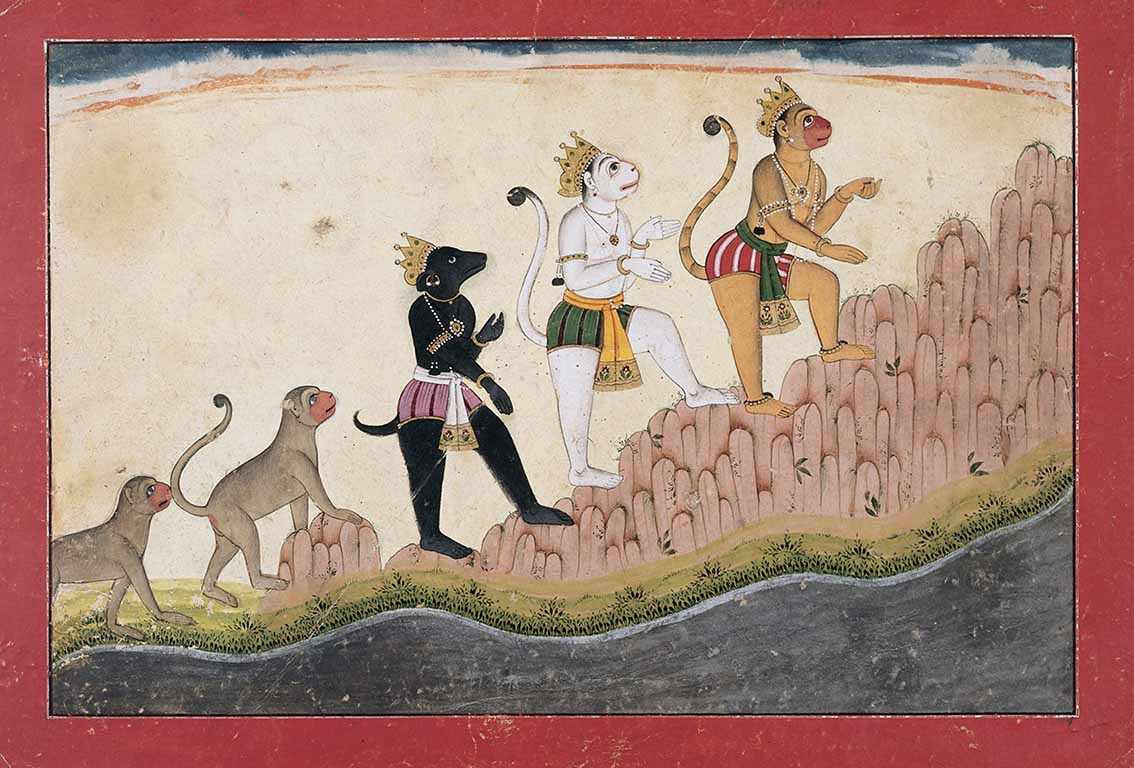The Rama Epic: Hero, Heroine, Ally, Foe at the Asian Art Museum, San Francisco is the most complete exploration of Ramayana-related art to be seen in the US. Exhibition curator and editor of the catalogue Forrest McGill has assembled 135 objects from the last 1,500 years, loaned by 28 institutions and private collections in the US, Britain, and Europe, and from the Museum’s own holdings.
Characters in the Ramayana
The exhibition galleries feature in turn Hero Rama, Heroine Sita, Ally Hanuman, and Foe Ravana in sculpture, paintings, manuscripts, puppets, masks, and textiles. One of the first is the splendid Chola bronze of Rama (fig 1) from the Asia Society, New York. Some of the story is seen in a fine embroidered Burmese textile with Rama bending the bow (fig 2) in the contest that leads to his marriage to Sita. Sita appears in another classic Chola bronze (fig 3) from the Linden-Museum, Stuttgart.
Perhaps the demon king Ravana should have appeared next in the exhibit sequence since his kidnapping of Sita occurs well before the appearance of Hanuman. And it is because of Ravana that the story has gripped so many throughout the ages. The Museum’s own impressive Balinese Ravana, here in closeup, is one of diverse representations of the ultimate antihero.
Hanuman in the Ramayana
In this exhibition of the Rama epic various character’s stories unfold. Hanuman the monkey general is enlisted to assist in rescuing Sita. The beloved Hanuman’s presence was and is widespread, including in Southeast Asia. He even appears supporting the Buddha and two disciples in a large Thai painting (fig 5). Newly acquired by the Asian Art Museum, and after 400 hours of meticulous restoration, it has yet to be studied in depth by scholars. Rama eventually encounters Ravana in a fight to the death (fig 6) from a series in a large-format manuscript depicting combat scenes in the Thai dance-drama.
The Story of the Ramayana
Alas, Sita’s ordeals are not over. When she returns with Rama to his kingdom he questions her purity since she had lived in another man’s home. Sita demands to undergo a trial by fire, a subject often depicted in Balinese painting; the one exhibited (cat no 73) is too large and detailed to include here. On the same subject there is a Malwa painting (cat no 49) and one by modern artist Jamini Roy (cat no 72).
Two Alternate Endings
The last gallery presents two alternate endings to the Ramayana. In the original Valmiki text Sita is called to undergo more hardship, is exiled again, their twin sons are born, and on her return is asked by Rama a second time to prove her fidelity. Sita reacts by calling upon her mother the Earth Goddess to swallow her, leaving the court stunned. This is related in the last of the seven volumes of Valmiki, often ignored by authors of later versions. The better known ‘lived happily ever after’ version appears on the opposite side of the gallery.
The Valmiki Ramayana Translation Project
Renowned leaders of the Valmiki Ramayana Translation Project, Robert Goldman and Sally Goldman, contribute important chapters: Robert, ‘The Story in the Ramayana of Valmiki’ and ‘Hero of a Thousand Texts’; and Sally, ‘A Heroine’s Journey’. Pika Ghosh, in ‘A Ramayana of One’s Own,’ relates ‘the pleasures and pangs’ of stories heard during her childhood in Bengal and of Rama’s devotion to the goddess Durga.
Philip Lutgendorf on Hanuman in the Rama epic ‘Alley, Devotee, and Friend’, tells his birth stories absent from the original text, and of the wide adoration the monkey deity receives today. McGill’s ‘Picturing Ravana’ explores the complexity of Ravana’s character, obviously a favourite of his and ours. The extensive catalogue entries were written by Qamar Adamjee, Jeffrey Durham, Ghosh, McGill, and Natasha Reichle.
Indian Miniatures of The Ramayana
The exhibition includes Indian miniature paintings from many sources including the British Library, eight from their famous Mewar Ramayana (1649-1653) never before seen in the US. It is possibly the first time five leaves from the Shangri Ramayana of a few decades later are together since the set was broken up (fig 7). The exhibition would have been a must-see even if only the miniatures had been shown. Also included are illustrations by 17th- and 19th-century European and contemporary Indian artists.
Video screens of mostly modern performances and TV series show how they have played an important part in continuing the epic in present-day India. An iPad displays a page from the Mewar Ramayana (cat no 134) while one hears Robert Goldman’s fine Sanskrit chanting of the text.
As Goldman writes (p 30), ‘many Hindu and Buddhist rulers invested heavily in the expansion of the temple cult of Rama. It can also be seen in the construction of sovereignty in premodern Java and Cambodia and in several nations of the region, such as Thailand, right down to today [King Rama IX died there recently].
Muslim Rulers Enamoured by the Rama Story
Even Muslim rulers were deeply enamoured of the Rama story, which came to be widely represented in the literature, visual, and performing arts of the Malay-Indonesian world. ‘Translations of the epic were commissioned by Mughal emperors and often illuminated (cat nos 12, 38 and 75).
In a museum it is easy to be struck by beautiful and interesting object and forget the living presence of the gods for Hindus. Rama, Sita, and Hanuman remain deities today in a very vibrant way in devotion, storytelling, and traditional theatre and dance. Careful exploration of the exhibition and catalogue is highly recommended.
BY GRAEME VANDERSTOEL
Until 15 January, at the Asian Art Museum, San Francisco. The 290-page catalogue is more than a supplement to the exhibition – The Rama Epic, edited by Forrest McGill, Asian Art Museum, ISBN 989093117765, $50









